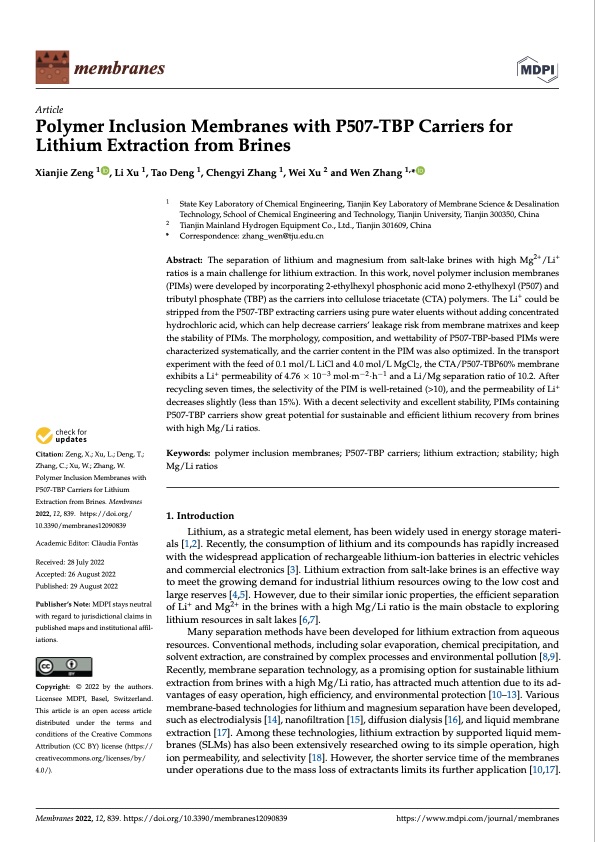
PDF Publication Title:
Text from PDF Page: 001
membranes Article Polymer Inclusion Membranes with P507-TBP Carriers for Lithium Extraction from Brines Xianjie Zeng 1 , Li Xu 1, Tao Deng 1, Chengyi Zhang 1, Wei Xu 2 and Wen Zhang 1,* 1 State Key Laboratory of Chemical Engineering, Tianjin Key Laboratory of Membrane Science & Desalination Technology, School of Chemical Engineering and Technology, Tianjin University, Tianjin 300350, China Tianjin Mainland Hydrogen Equipment Co., Ltd., Tianjin 301609, China Citation: Zeng, X.; Xu, L.; Deng, T.; Zhang, C.; Xu, W.; Zhang, W. Polymer Inclusion Membranes with P507-TBP Carriers for Lithium Extraction from Brines. Membranes 2022,12,839. https://doi.org/ 10.3390/membranes12090839 Academic Editor: Clàudia Fontàs Received: 28 July 2022 Accepted: 26 August 2022 Published: 29 August 2022 Publisher’s Note: MDPI stays neutral with regard to jurisdictional claims in published maps and institutional affil- iations. Copyright: © 2022 by the authors. Licensee MDPI, Basel, Switzerland. This article is an open access article distributed under the terms and conditions of the Creative Commons Attribution (CC BY) license (https:// creativecommons.org/licenses/by/ 4.0/). Abstract: The separation of lithium and magnesium from salt-lake brines with high Mg2+/Li+ ratios is a main challenge for lithium extraction. In this work, novel polymer inclusion membranes (PIMs) were developed by incorporating 2-ethylhexyl phosphonic acid mono 2-ethylhexyl (P507) and tributyl phosphate (TBP) as the carriers into cellulose triacetate (CTA) polymers. The Li+ could be stripped from the P507-TBP extracting carriers using pure water eluents without adding concentrated hydrochloric acid, which can help decrease carriers’ leakage risk from membrane matrixes and keep the stability of PIMs. The morphology, composition, and wettability of P507-TBP-based PIMs were characterized systematically, and the carrier content in the PIM was also optimized. In the transport experiment with the feed of 0.1 mol/L LiCl and 4.0 mol/L MgCl2, the CTA/P507-TBP60% membrane exhibits a Li+ permeability of 4.76 × 10−3 mol·m−2·h−1 and a Li/Mg separation ratio of 10.2. After recycling seven times, the selectivity of the PIM is well-retained (>10), and the permeability of Li+ decreases slightly (less than 15%). With a decent selectivity and excellent stability, PIMs containing P507-TBP carriers show great potential for sustainable and efficient lithium recovery from brines with high Mg/Li ratios. Keywords: polymer inclusion membranes; P507-TBP carriers; lithium extraction; stability; high Mg/Li ratios 1. Introduction Lithium, as a strategic metal element, has been widely used in energy storage materi- als [1,2]. Recently, the consumption of lithium and its compounds has rapidly increased with the widespread application of rechargeable lithium-ion batteries in electric vehicles and commercial electronics [3]. Lithium extraction from salt-lake brines is an effective way to meet the growing demand for industrial lithium resources owing to the low cost and large reserves [4,5]. However, due to their similar ionic properties, the efficient separation of Li+ and Mg2+ in the brines with a high Mg/Li ratio is the main obstacle to exploring lithium resources in salt lakes [6,7]. Many separation methods have been developed for lithium extraction from aqueous resources. Conventional methods, including solar evaporation, chemical precipitation, and solvent extraction, are constrained by complex processes and environmental pollution [8,9]. Recently, membrane separation technology, as a promising option for sustainable lithium extraction from brines with a high Mg/Li ratio, has attracted much attention due to its ad- vantages of easy operation, high efficiency, and environmental protection [10–13]. Various membrane-based technologies for lithium and magnesium separation have been developed, such as electrodialysis [14], nanofiltration [15], diffusion dialysis [16], and liquid membrane extraction [17]. Among these technologies, lithium extraction by supported liquid mem- branes (SLMs) has also been extensively researched owing to its simple operation, high ion permeability, and selectivity [18]. However, the shorter service time of the membranes under operations due to the mass loss of extractants limits its further application [10,17]. 2 * Correspondence: zhang_wen@tju.edu.cn Membranes 2022, 12, 839. https://doi.org/10.3390/membranes12090839 https://www.mdpi.com/journal/membranesPDF Image | P507 TBP Carriers for Lithium Extraction from Brines

PDF Search Title:
P507 TBP Carriers for Lithium Extraction from BrinesOriginal File Name Searched:
membranes-12-00839.pdfDIY PDF Search: Google It | Yahoo | Bing
Product and Development Focus for Infinity Turbine
ORC Waste Heat Turbine and ORC System Build Plans: All turbine plans are $10,000 each. This allows you to build a system and then consider licensing for production after you have completed and tested a unit.Redox Flow Battery Technology: With the advent of the new USA tax credits for producing and selling batteries ($35/kW) we are focussing on a simple flow battery using shipping containers as the modular electrolyte storage units with tax credits up to $140,000 per system. Our main focus is on the salt battery. This battery can be used for both thermal and electrical storage applications. We call it the Cogeneration Battery or Cogen Battery. One project is converting salt (brine) based water conditioners to simultaneously produce power. In addition, there are many opportunities to extract Lithium from brine (salt lakes, groundwater, and producer water).Salt water or brine are huge sources for lithium. Most of the worlds lithium is acquired from a brine source. It's even in seawater in a low concentration. Brine is also a byproduct of huge powerplants, which can now use that as an electrolyte and a huge flow battery (which allows storage at the source).We welcome any business and equipment inquiries, as well as licensing our turbines for manufacturing.| CONTACT TEL: 608-238-6001 Email: greg@infinityturbine.com | RSS | AMP |